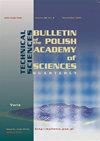数字图像处理沥青混合料的集料分割
IF 1.1
4区 工程技术
Q3 ENGINEERING, MULTIDISCIPLINARY
Bulletin of the Polish Academy of Sciences-Technical Sciences
Pub Date : 2023-11-06
DOI:10.24425/bpas.2019.128115
引用次数: 4
摘要
本文章由计算机程序翻译,如有差异,请以英文原文为准。
Aggregate segmentation of asphaltic mixes using digital image processing
. The study of the different engineering materials according to their mechanical and dynamic characteristics has become an area of research interest in recent years. Several studies have verified that the mechanical properties of the material are directly affected by the distribution and size of the particles that compose it. Such is the case of asphalt mixtures. For this reason, different digital tools have been developed in order to be able to detect the structural components of the elements in a precise, clear and efficient manner. In this work, a segmentation model is developed for different types of dense-graded asphalt mixtures with grain sizes from 9.5 mm to 0.0075 mm, using sieve size reconstruction of the laboratory production curve. The laboratory curve is used to validate the particles detection model that uses morphological operations for elements separation. All this with the objective of developing a versatile tool for the analysis and study of pavement structures in a non-destructive test. The results show that the model presented in this work is able to segment elements with an area greater than 0.0324 mm 2 and reproduce the sieve size curves of the mixtures with a high percentage of precision.
求助全文
通过发布文献求助,成功后即可免费获取论文全文。
去求助
来源期刊
CiteScore
2.80
自引率
16.70%
发文量
0
审稿时长
6-12 weeks
期刊介绍:
The Bulletin of the Polish Academy of Sciences: Technical Sciences is published bimonthly by the Division IV Engineering Sciences of the Polish Academy of Sciences, since the beginning of the existence of the PAS in 1952. The journal is peer‐reviewed and is published both in printed and electronic form. It is established for the publication of original high quality papers from multidisciplinary Engineering sciences with the following topics preferred:
Artificial and Computational Intelligence,
Biomedical Engineering and Biotechnology,
Civil Engineering,
Control, Informatics and Robotics,
Electronics, Telecommunication and Optoelectronics,
Mechanical and Aeronautical Engineering, Thermodynamics,
Material Science and Nanotechnology,
Power Systems and Power Electronics.

 求助内容:
求助内容: 应助结果提醒方式:
应助结果提醒方式:


